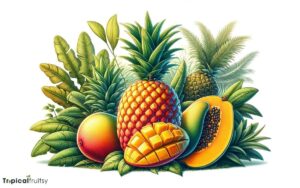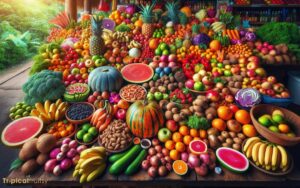Difference Between Tropical and Subtropical Fruits: Compare!
Tropical fruits are grown near the equator and require a consistently warm and humid climate, leading to juicy, flavorful produce.
Subtropical fruits grow in regions with hot summers and mild winters, adapting to some temperature fluctuations, and offering a variety of tastes and benefits. The primary distinction between tropical and subtropical fruits lies in their growing conditions.
Tropical fruits, such as bananas, mangoes, and pineapples, thrive in areas with year-round warmth and high humidity. These fruits are known for their intense flavors and juiciness.
Subtropical fruits, including oranges, avocados, and peaches, are cultivated in regions with warm summers and cooler winters, and they can tolerate cooler temperatures better than tropical fruits.
While both types of fruits contribute to a healthy diet, their nutritional profiles and flavors differ due to their distinct growing environments.
Example of Tropical Fruit: Mango – thrives in warm, humid conditions.
Example of Subtropical Fruit: Orange – can tolerate cooler temperatures.
Explore the diverse world of fruits where climate shapes flavor and resilience.
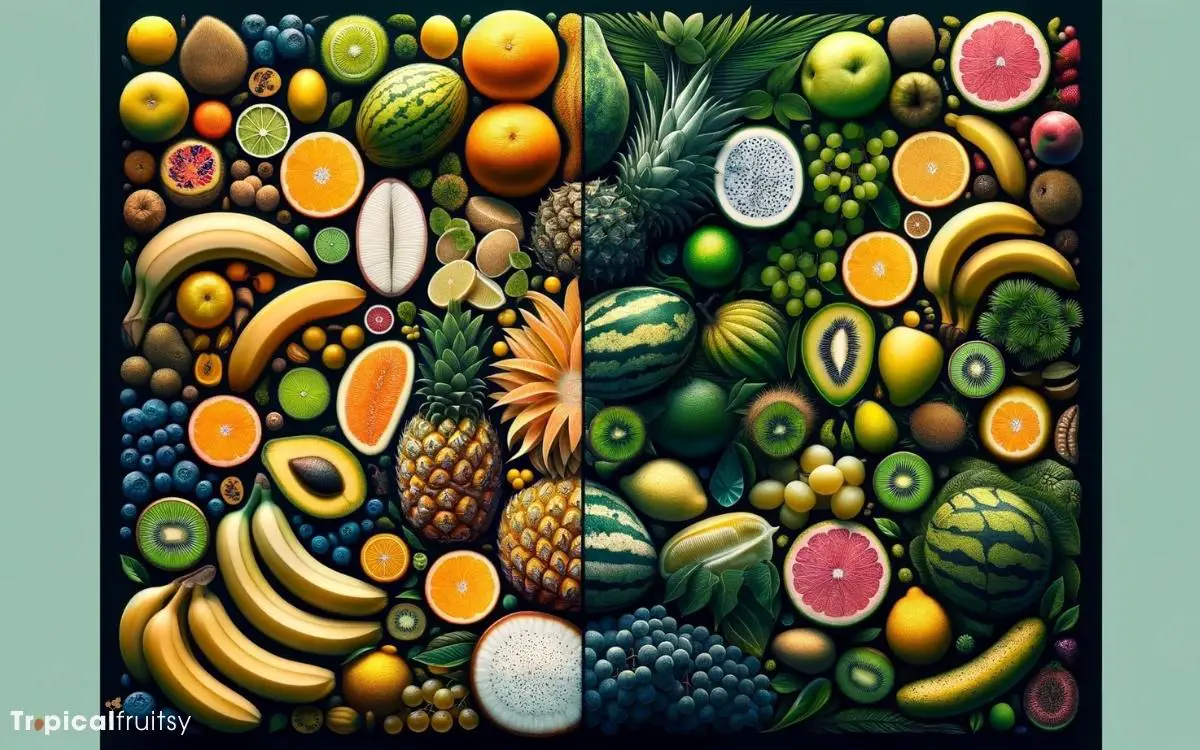
Key Takeaway
6 Characteristics: Tropical Fruits and Subtropical Fruits
| Characteristics | Tropical Fruits | Subtropical Fruits |
|---|---|---|
| Climate | Warm and humid | Warm summers, mild winters |
| Temperature Consistency | Consistently high | Varies seasonally |
| Common Examples | Mango, Banana, Papaya | Orange, Avocado, Peach |
| Flavor Profile | Vibrant and juicy | Wide range of flavors |
| Temperature Tolerance | Low | Moderate to high |
| Seasonal Availability | Year-round in tropics | Season-specific |
Tropical and Subtropical Fruits List
Tropical and subtropical fruits come from regions with warm climates and are often characterized by their exotic flavors and vibrant colors.
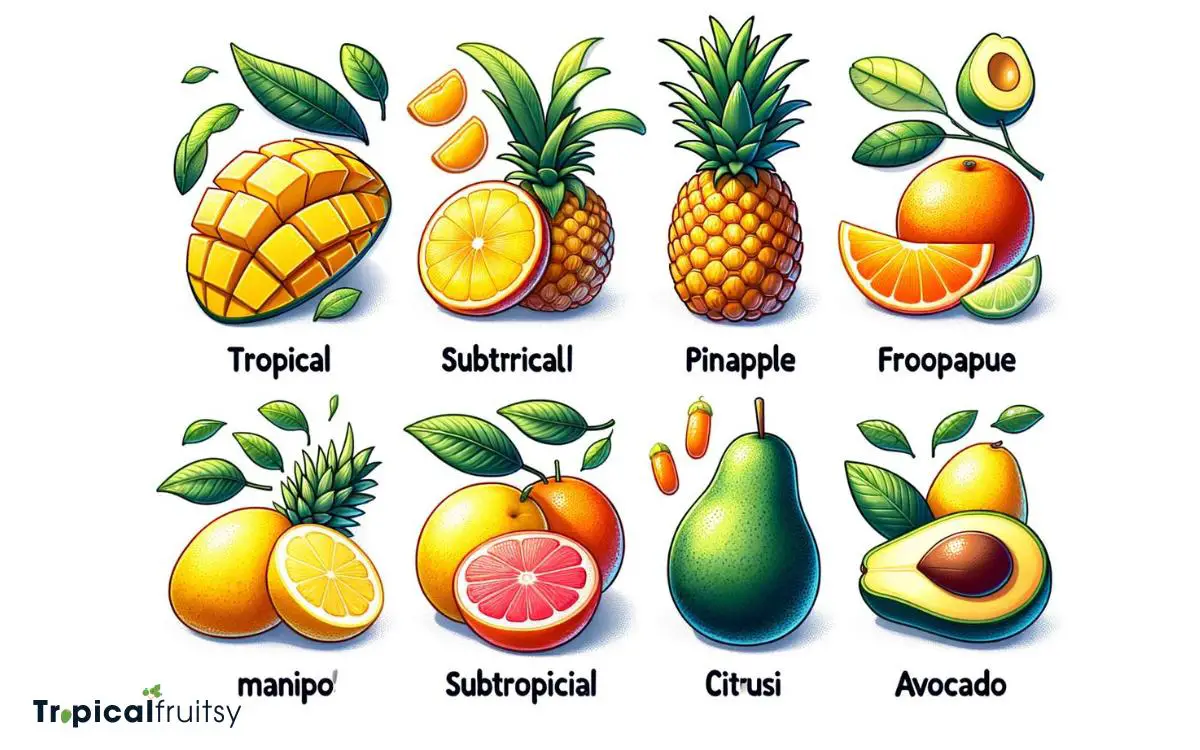
Here’s a list of some common and less known tropical and subtropical fruits:
- Mango: A sweet, juicy fruit with a stone in the middle, mangoes are popular worldwide and come in various shapes and sizes.
- Papaya: Large and oval, papayas have a sweet, orange flesh and are often eaten fresh or used in fruit salads.
- Pineapple: With its spiky skin and sweet, tangy flesh, pineapples are a staple in tropical fruit selections.
- Banana: A well-known fruit, bananas are long and curved with a soft, sweet flesh inside a peel.
- Coconut: A large, nut-like fruit with a hard shell, coconut flesh is white and firm, often used in cooking and for its milk.
- Guava: A small, round fruit with a sweet, fragrant flesh that can be white, pink, or red inside.
- Lychee: Small, round fruits with a rough skin that peels away to reveal sweet, translucent flesh.
- Passion Fruit: Small and round with a tough outer rind, passion fruits contain a juicy, seed-filled interior.
- Starfruit (Carambola): Star-shaped when sliced, starfruits have a waxy skin and a tart, juicy flesh.
- Durian: Known for its strong odor, durian has a spiky outer shell and a creamy, rich flesh that’s loved by some and disliked by others.
- Dragon Fruit (Pitaya): With a striking appearance, dragon fruits have a bright pink or yellow skin and a speckled, sweet flesh.
- Jackfruit: The largest tree-borne fruit, jackfruit has a spiky outer shell and a sweet, chewy flesh that’s used in both sweet and savory dishes.
- Kiwano (Horned Melon): An exotic fruit with horn-like spines, kiwano has a jelly-like, green flesh that’s mildly sweet.
- Tamarind: A pod-like fruit, tamarind has a tangy pulp that’s often used as a flavoring in cooking.
- Feijoa (Pineapple Guava): Small and oval-shaped, feijoas have a sweet, aromatic flesh and a slightly tart flavor.
- Cherimoya (Custard Apple): Cherimoyas have a creamy texture and a sweet, complex flavor that’s often described as a mix of banana, pineapple, and strawberry.
- Sapodilla: A brown, kiwi-sized fruit with a grainy, sweet flesh that tastes like a pear mixed with brown sugar.
- Rambutan: Similar to lychee, rambutans have a hairy outer skin and a sweet, juicy flesh inside.
- Longan: Small, round fruits with a translucent flesh, longans are sweet and aromatic, similar to lychees in flavor.
- Ugli Fruit (Unique Fruit): A hybrid citrus fruit, ugli fruit has a rough, wrinkled skin and a sweet, tangy flesh.
These fruits are often enjoyed fresh, but they are also used in cooking, baking, smoothies, and juices. Each has its unique flavor and health benefits, making them a delightful addition to any diet.
Defining Climate Zones
Climate zones significantly influence the cultivation and diversity of fruit species. These zones are demarcated by latitudinal belts, which determine the general climatic conditions an area may experience.
The tropics, lying between the Tropic of Cancer and the Tropic of Capricorn, have warm climates with minimal temperature variations and abundant rainfall, fostering a year-round growing season.
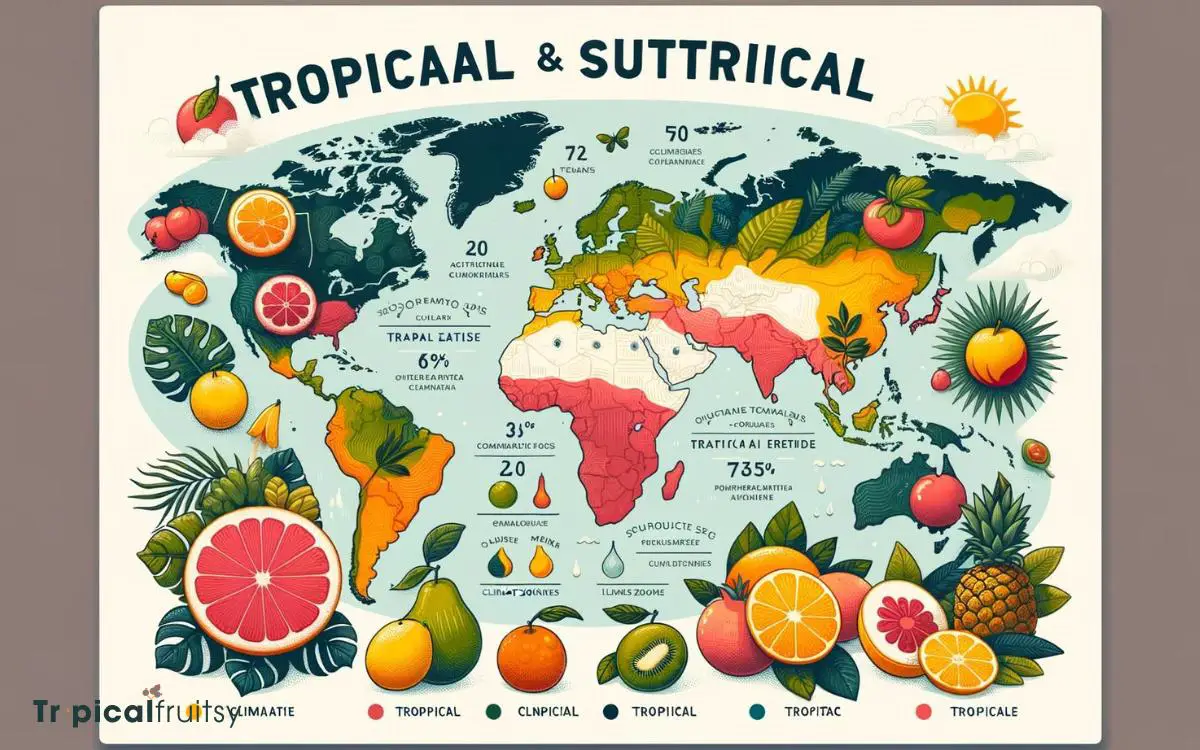
Subtropical regions, situated just north and south of the tropics, experience greater seasonal variation, with hot, humid summers and cooler winters.
Understanding these climatic demarcations is essential for agriculture, as they dictate the viability of fruit species in different regions.
This precision in climatic comprehension seamlessly leads us to examine the specific characteristics of fruits that thrive within the tropical zone.
Tropical Fruit Characteristics
Tropical fruits, flourishing in regions with year-round warmth and ample moisture, typically exhibit lush textures, vibrant colors, and a wide array of exotic flavors.
These fruits originate from the equatorial zones where the climate is conducive to the growth of a diverse range of species.
Characterized by their nutritional richness, many tropical fruits are high in vitamins, antioxidants, and other phytochemicals beneficial to human health.
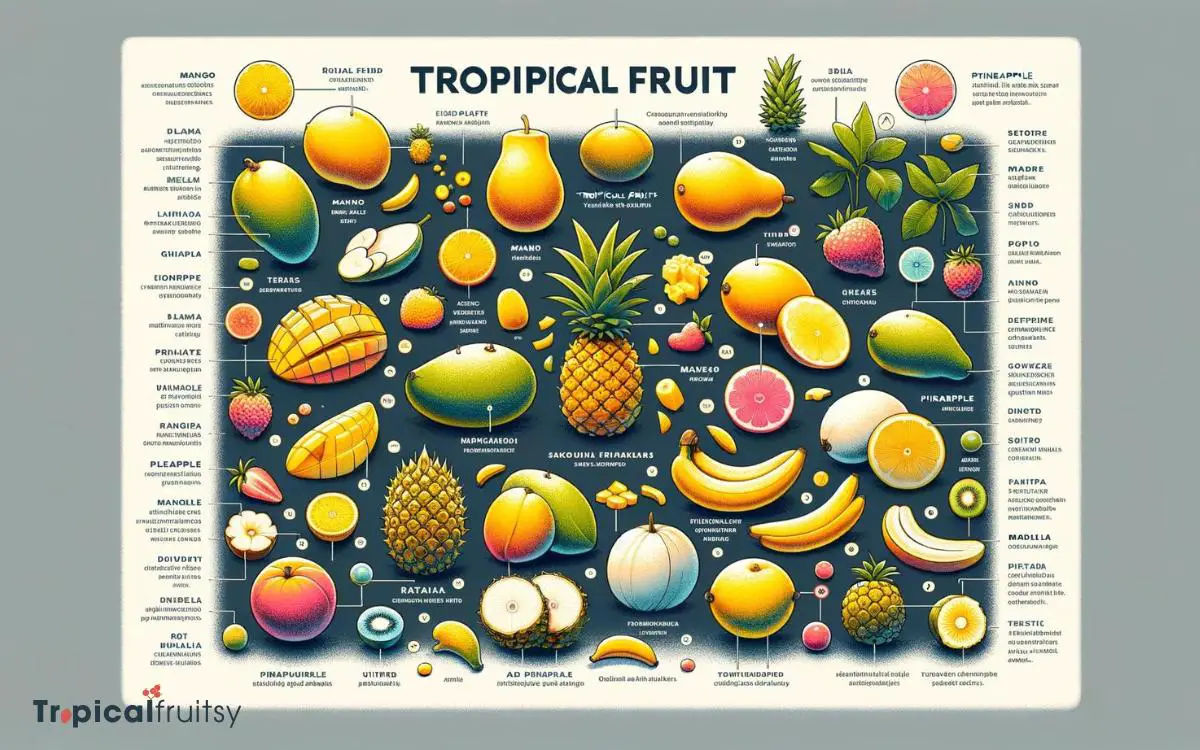
The thick skins and husks of some tropical fruits serve as natural barriers against pests, while others have developed unique methods of seed dispersal to thrive in the dense ecosystems.
Analyzing their ecological adaptations reveals a fascinating intersection of botany and evolutionary biology.
As we transition to subtropical fruit profiles, it is essential to note the subtle shifts in environmental demands that influence their distinct characteristics.
Subtropical Fruit Profiles
Subtropical fruits, such as peaches, avocados, and lychees, thrive in regions that experience a more temperate climate with distinct warm and cool seasons, setting them apart from their tropical counterparts.
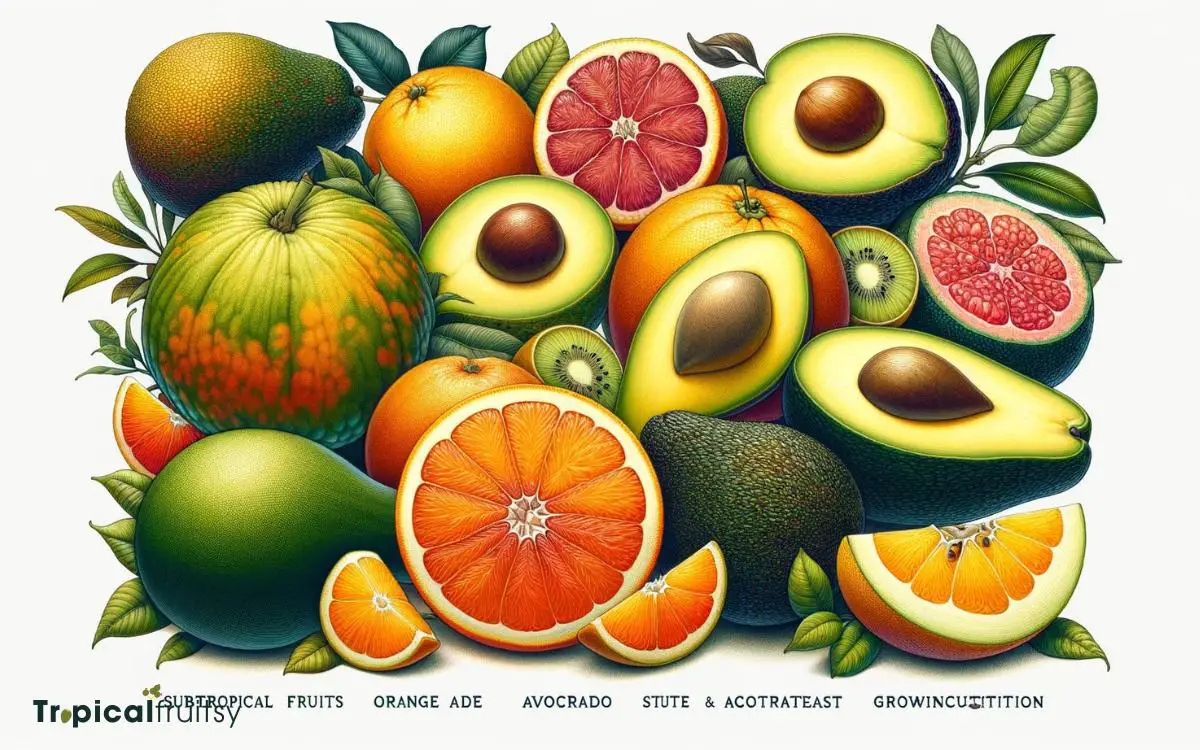
These fruits often require specific conditions to flourish:
- Peaches: Demand well-drained, fertile soil; they are sensitive to extreme cold but need chill hours for bud development.
- Avocados: Prefer consistent warmth, but can tolerate brief cold snaps; they require deep, rich soil and ample irrigation.
- Lychees: Need a warm, frost-free environment with high humidity; they thrive in acidic, well-draining soil.
- Citrus varieties: Grow best with warm summers and mild winters; they need regular watering and well-drained soil, preferably slightly acidic.
Understanding these profiles is fundamental to successful cultivation and harvesting practices, which are explored in the following section.
Cultivation and Harvesting
Cultivation and harvesting practices for tropical and subtropical fruits are significantly influenced by regional climatic conditions, necessitating distinct approaches to ensure optimal yield.
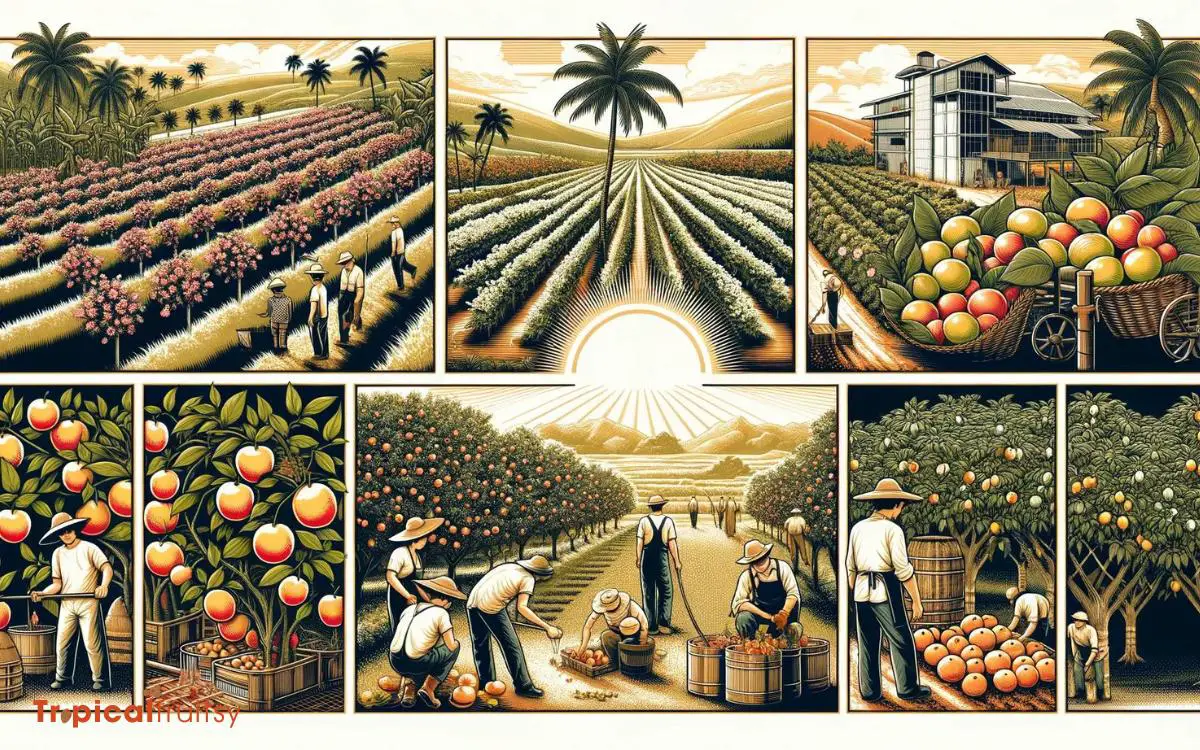
Seasonal growing cycles dictate not only the timing of planting and harvesting but also the methodology applied to manage pests, diseases, and soil health.
The strategic implementation of these agricultural practices is critical in mitigating the risks associated with variable weather patterns and in maximizing the quality and quantity of the produce obtained.
Climate Impact
In terms of climate influence, the successful cultivation and harvesting of fruits largely hinge on the specific temperature ranges and environmental conditions that define tropical and subtropical regions.
These areas exhibit distinct characteristics that affect fruit production:
- Temperature: Tropical fruits require consistently high temperatures, while subtropical fruits can tolerate cooler temperatures and occasional mild frosts.
- Humidity: High humidity in the tropics supports the growth of fruits like bananas and pineapples, whereas subtropical fruits such as citrus and avocados may prefer lower humidity.
- Rainfall: Adequate rainfall is crucial for tropical fruit cultivation; irrigation may be necessary in drier subtropical zones.
- Soil Type: Both regions require well-drained soils, but nutrient content and pH levels can vary significantly, impacting fruit quality and yield.
Understanding these climatic factors enables growers to optimize their practices, leading seamlessly into the discussion of seasonal growing cycles.
Seasonal Growing Cycles
Regarding seasonal growing cycles, tropical fruits typically have a continuous harvesting period due to the unvarying climate, while subtropical fruits often adhere to more defined seasonal patterns.
In the equatorial belt, where tropical fruits flourish, temperatures and daylight hours remain relatively consistent throughout the year, allowing for a perennial growth cycle.
This climatic stability enables year-round cultivation, with some species producing multiple harvests annually.
Conversely, subtropical regions experience greater climatic variation, with distinct warm and cool seasons.
Subtropical fruit trees may require a period of dormancy, usually induced by cooler temperatures, to stimulate flowering and fruiting.
Hence, their cultivation and harvesting align with these cyclical climate changes, resulting in specific harvest seasons that vary from one subtropical zone to another.
Flavor and Nutritional Differences
Amidst the diverse range of fruit varieties, tropical fruits typically exhibit a sweeter, more intense flavor profile and distinct nutritional compositions compared to their subtropical counterparts.
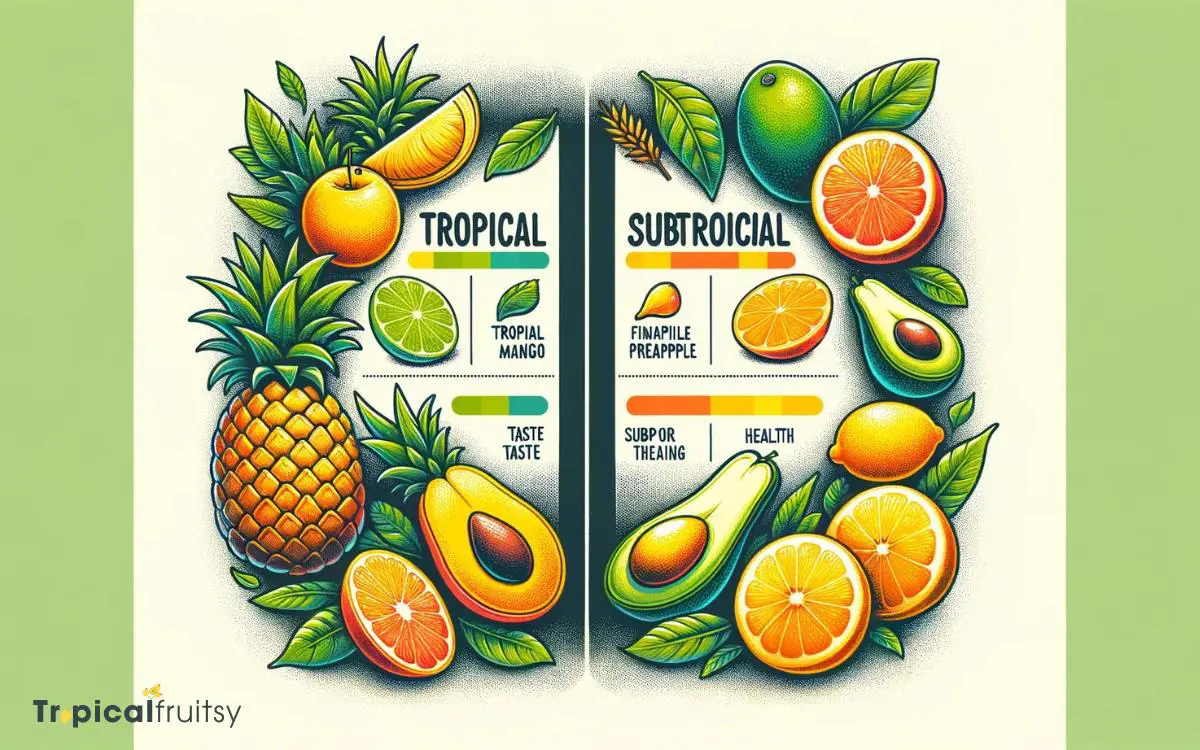
This distinction can be attributed to several factors:
- Sugar Content: Tropical fruits often have higher sugar concentrations, contributing to their pronounced sweetness and vibrant tastes.
- Nutrient Density: They are generally rich in vitamins, particularly Vitamin C and A, which are abundant in fruits like mangoes and papayas.
- Antioxidant Levels: Exotic tropical varieties tend to contain greater levels of antioxidants, which are instrumental in combating oxidative stress.
- Aromatic Compounds: The complex mixture of volatile compounds in tropical fruits results in their powerful aromas and flavors, unlike the milder scents and tastes of subtropical fruits.
Analyzing these aspects helps to understand the nutritional and sensory experiences provided by each category of fruit.
Common Tropical and Subtropical Examples
Moving beyond the sensory and nutritional profiles, identifying specific fruits that epitomize the tropical and subtropical categories is essential for a comprehensive understanding.
Popular tropical fruits such as bananas, mangoes, and pineapples have distinct growth requirements that typify the tropical climate’s consistent warmth and humidity.
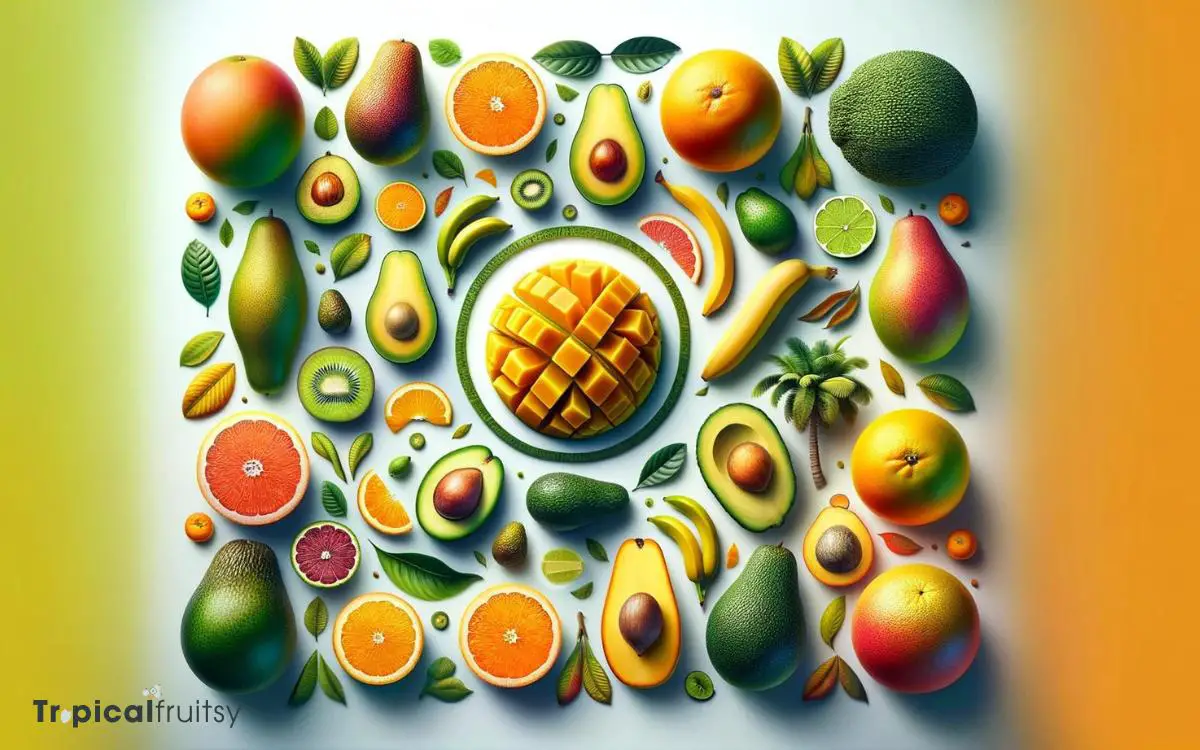
Conversely, subtropical fruits like oranges, avocados, and lychees thrive in regions that experience a wider range of temperatures, reflecting their adaptability to both warm and cooler conditions.
Popular Tropical Fruits
While many fruits thrive in the warmth of tropical climates, some of the most popular include bananas, pineapples, and mangoes, which are known for their sweet flavors and nutritional benefits.
These fruits not only dominate the tropical fruit market but also offer a wealth of health advantages and culinary versatility.
To delineate their significance:
- Bananas: Rich in potassium and vitamins, bananas are indispensable for their energy-boosting properties and ease of consumption.
- Pineapples: Laden with vitamin C and digestive enzymes like bromelain, pineapples are both a healthful and refreshing choice.
- Mangoes: With their abundance of vitamins A and C, mangoes boast antioxidant qualities and a succulent taste profile.
- Papayas: Containing papain, an enzyme that aids digestion, papayas are also a source of vitamin C and folate.
These fruits are not only essential to tropical agriculture but also play a pivotal role in global nutrition and gastronomy.
Subtropical Fruit Varieties
Subtropical regions contribute a diverse array of fruits such as avocados, citrus, and figs, which thrive in climates that are warmer than temperate zones yet cooler than the tropics.
These fruits typically require a moderate climate with a distinct winter period that is not excessively cold, allowing them to develop unique characteristics in terms of flavor, texture, and nutritional content.
Citrus fruits, including oranges, lemons, limes, and grapefruit, are hallmarks of subtropical agriculture, valued for their vitamin C content and versatile use.
Avocados, rich in healthy fats, prosper in similar conditions, as do figs, which demand a dry, warm season for optimal sweetness.
Subtropical fruit cultivation hinges on understanding the delicate balance between temperature extremes, ensuring that each variety reaches its full potential for consumption and marketability.
How Do the Health Benefits of Subtropical Fruits Compare to Tropical Fruits?
When it comes to “tropical fruit health benefits explained,” subtropical and tropical fruits offer a variety of nutrients. While tropical fruits like mangoes and pineapples are rich in vitamin C and antioxidants, subtropical fruits such as avocado and kiwi provide healthy fats and high levels of vitamin E. Both types bring unique benefits to the table.
Storage and Consumption Tips
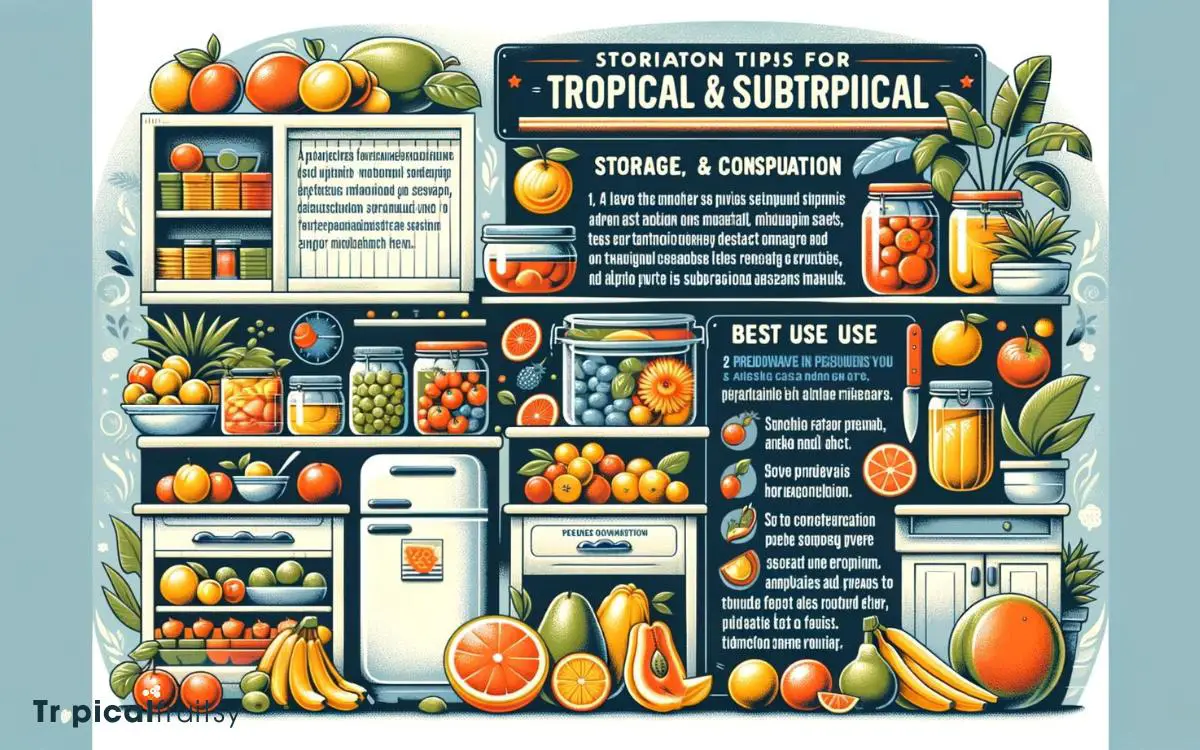
Proper storage and handling of tropical and subtropical fruits are essential to maintain their freshness and nutritional value after purchase.
To achieve this, consider the following guidelines:
- Temperature Regulation: Store tropical fruits at room temperature to allow proper ripening. Subtropical fruits often require refrigeration to prolong freshness.
- Humidity Control: Use ventilated packaging to reduce excess moisture, which can lead to spoilage.
- Ethylene Sensitivity: Separate fruits that emit ethylene gas from those that are sensitive to it to prevent premature ripening or decay.
- Timely Consumption: Plan to consume these fruits when they reach peak ripeness for optimal flavor and nutritional benefit.
Adhering to these storage and consumption tips will ensure that the delicate balance of taste and health benefits these fruits provide is preserved.
Conclusion
The distinction between tropical and subtropical fruits is underscored by their unique climate requirements, growth patterns, and sensory profiles.
These fruits not only contribute to global biodiversity but also offer a cornucopia of flavors and nutritional benefits.
By understanding their differences, consumers can better appreciate the agricultural intricacies and make informed choices that support both their health and the environment.
The harmony in diversity of these fruits mirrors the intricate balance of Earth’s ecosystems.


